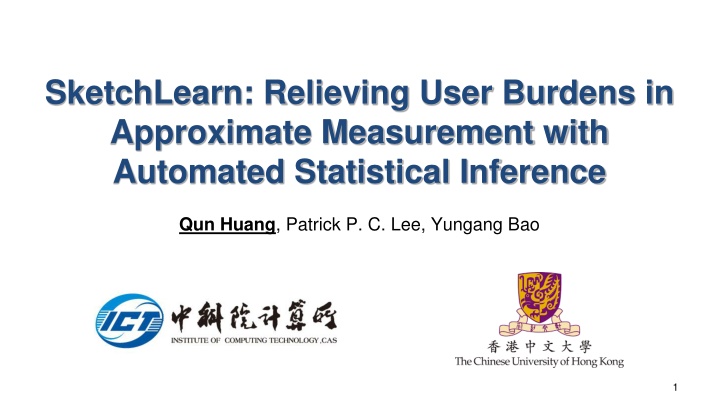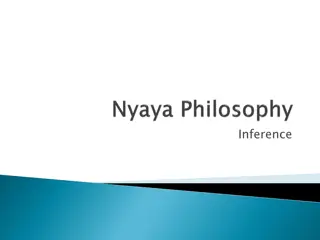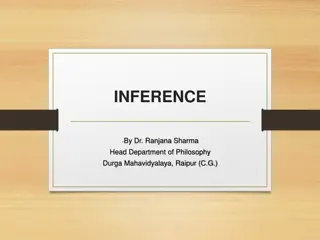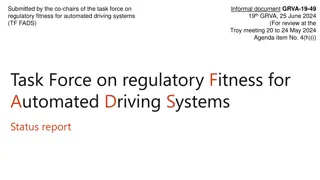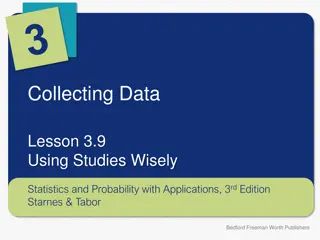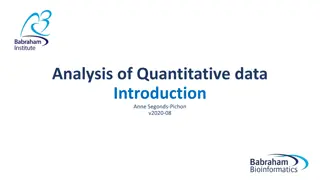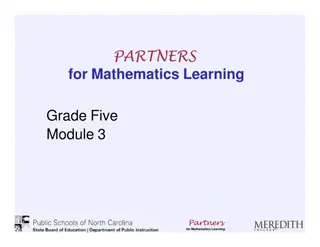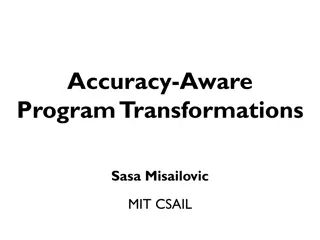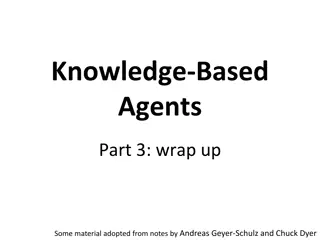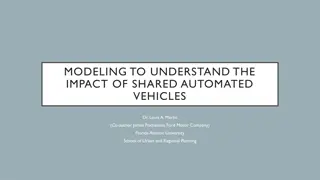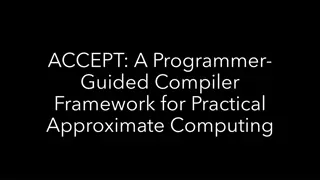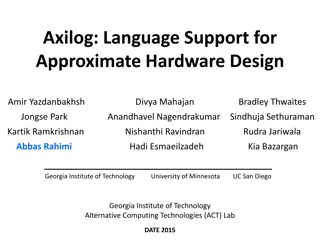Automated Statistical Inference for Approximate Measurement Burdens
SketchLearn explores relieving user burdens in approximate measurement through automated statistical inference. The research delves into addressing challenges such as specifying errors, defining thresholds, handling network traffic, and optimizing measurement algorithms. By identifying and mitigating user burdens, the goal is to enhance the efficiency and accuracy of approximate measurements.
Download Presentation

Please find below an Image/Link to download the presentation.
The content on the website is provided AS IS for your information and personal use only. It may not be sold, licensed, or shared on other websites without obtaining consent from the author.If you encounter any issues during the download, it is possible that the publisher has removed the file from their server.
You are allowed to download the files provided on this website for personal or commercial use, subject to the condition that they are used lawfully. All files are the property of their respective owners.
The content on the website is provided AS IS for your information and personal use only. It may not be sold, licensed, or shared on other websites without obtaining consent from the author.
E N D
Presentation Transcript
SketchLearn: Relieving User Burdens in Approximate Measurement with Automated Statistical Inference Qun Huang, Patrick P. C. Lee, Yungang Bao 1
Typical Approximate Measurement Expected errors Query thresholds Network traffic Query Measurement Algorithm Measurement Results Configuration Domain knowledge Network statistics Our goal: identify and relieve user burdens for approximate measurement 2
User Burden 1 1: Hard to specify Expected errors Query thresholds Network traffic Query Measurement Algorithm Measurement Results Configuration Domain knowledge Network statistics Errors need to be specified: bias: an answer deviates true answer by failure probability: fail to produce small-error answer with a probability 3
User Burden 2 1: Hard to specify 2: Hard to know in advance Expected errors Query thresholds Network traffic Query Measurement Algorithm Measurement Results Configuration Domain knowledge Network statistics Large-threshold configurations fail to work for small-threshold queries No guideline for sufficiently small threshold Vary across management operations and traffic characteristics 4
User Burden 3 1: Hard to specify 2: Hard to know in advance Expected errors Query thresholds Network traffic Query Measurement Algorithm Measurement Results Configuration Domain knowledge Network statistics 3: Hard to follow theory to tune Domain knowledge is not always available Theories usually show worst-case results Configuration for worst case not practically efficient 5
User Burden 4 1: Hard to specify 2: Hard to know in advance 4: Hard to redefine flow-keys Expected errors Query thresholds Network traffic Query Measurement Algorithm Measurement Results Configuration Domain knowledge Network statistics 3: Hard to follow theory to tune Algorithm works on a particular flow-key Flow-key definition must be fixed in deployment 6
User Burden 5 1: Hard to specify 2: Hard to know in advance 4: Hard to redefine flow-keys Expected errors Query thresholds Network traffic Query Measurement Algorithm Measurement Results Configuration Domain knowledge Query Results 3: Hard to follow theory to tune 5: Hard to quantify actual errors Infeasible to track errors for a particular flow Configuration only tells worst-case and overall errors 7
All User Burdens 1: Hard to specify 2: Hard to know in advance 4: Hard to redefine flow-keys Expected errors Query thresholds Network traffic Query Measurement Algorithm Measurement Results Configuration Domain knowledge Query Results 3: Hard to follow theory to tune 5: Hard to quantify actual errors 8
Our Work SketchLearn: Sketch-based measurement system with limited user burdens Relieve five user burdens Performance Catch up with underlying packet forwarding speed Memory efficiency Consume only limited memory Accuracy Preserve high accuracy of sketches Generality One design and one configuration for multiple tasks Deployable in both software and hardware 9
Root Cause: Resource Conflicts Previous work: perfect configuration to eliminate conflicts Determined by many factors Input data Configuration Query parameters Flow definition Algorithm Resource conflicts 10
High-Level Idea Not pursue perfect configurations to mitigate resource conflicts Hard to identify right trade-offs Characterize resource conflicts in an imperfect configuration Expected errors Query parameters Data structure with imperfect configuration Statistical Properties Conflict model Domain knowledge Flow definitions Not necessary Network queries 11
How to Realize? Data structure with imperfect configuration Statistical Properties Conflict model Network queries 12
Design Data Structure Data structure with imperfect configuration Statistical Properties Conflict model Network queries 13
Multi-level Sketch [Cormode, ToN 05] L: # of bits considered Data structure: L+1 levels (from 0 to L), each of which is a counter matrix Level 0 is always updated Level k is updated iff k-th bit in a flowkey is 1 All levels share same hash functions 14
Statistical Properties of Resource Conflicts Multi-level Sketch Statistical Properties Conflict model Network queries 15
Properties Does a flow update level k? Depends on inherent distribution of flow keys Does a flow update bucket (i, j)? Depends on hash functions of sketch A theory should characterize the above two factors 16
Main Theorem p[k]: probability that k-th bit is 1 Vi,j? : counter of bucket (i,j) Vi,j0 : counter of bucket (i,j) Vi,j? Vi,j0 random variable Ri,jk = Main Theorem: if no large flows, Ri,jk follows Gaussian distribution with mean p[k] 17
Build Conflict Model Multi-level Sketch Main Theorem Conflict model Network queries 18
Statistical Model Inference Goals Extract all large flows Guarantee remaining flows in sketches are small Estimate Gaussian distributions for each level Challenges No guidelines to distinguish large and small flows 19
Self-Adaptive Inference Algorithm Multi-Level Sketch Estimate Gaussian distributions Remove extracted large flows Flow extracted Use smaller threshold No flow extracted Imperfect Large Flows Gaussian Distribution Extract large flows 20
Self-Adaptive Inference Algorithm Multi-Level Sketch Estimate Gaussian distributions Remove extracted large flows Flow extracted Use smaller threshold No flow extracted Imperfect Large Flows Gaussian Distribution Extract large flows 21
Large Flow Extraction Intuition: a large flow (i) results in extremely (large or small) Ri,jk , or (ii) at least deviates Ri,jk from its expectation p[k] significantly Key idea: examine Ri,jk and its difference from p[k], then Determine k-th bit of a large flow (assuming it exists) Estimate frequency Associate flow confidence More details in paper! 22
Guarantee Theorem: w is sketch width, flows exceeding 1/w of total must be extracted Empirical results: even flows that are smaller than 1/w can also be extracted 64KB: flows above 0.6% of total traffic can be extracted (by theorem) Practice: >99% flows exceeding 0.3% are also extracted with 64KB 23
How to Perform Network-wide Queries? Multi-level Sketch Decoupled Components Conflict Characteristics Main Theorem Extracted Large Flows Flow Self-adaptive Model Inference Confidence Residual Sketch Gaussian Distributions Network queries 24
Supported Network Queries Per-flow byte count Heavy hitter detection Heavy changer detection Cardinality estimation Flow size distribution estimation Entropy estimation 25
Extended Query Model Allow query for arbitrary flowkeys Only use corresponding levels Estimate actual query errors Use attached errors for each large flow Use Gaussian distributions 26
Putting It Together Multi-level Sketch Decoupled Components Conflict Characteristics Main Theorem Extracted Large Flows Flow Self-adaptive Model Inference Confidence Residual Sketch Gaussian Distributions Network-wide Query Runtime 27
(Slight) User Burdens Users now just need to configure the multi-level sketch Multi-level Sketch Expected errors One row suffices Query parameters Domain knowledge Flow definitions Not necessary Columns: based on minimum flow or memory budget 400 KB memory Require flows exceeding 0.1% Example: 1000 columns 28
Implementation Challenge: updating L+1 levels is time consuming Solution: parallel updating L+1 levels are independent Software Based on OpenVSwitch + DPDK Parallelism with SIMD Hardware Based on P4 programmable switches Parallelism with P4 pipeline stages 29
Evaluation Platforms Software: OpenVSwitch + DPDK Hardware: Tofino swtich Large-scale simulation Traces Caida 2017 Data center traffic (IMC 2010) 30
Fitting Theorem Guaranteed boundary of flow extraction Flows that are guaranteed to be extracted Flows that are not guaranteed (but are likely) to be extracted 31
Arbitrary Flow Keys Query for three flow keys Heavy hitter detection Traffic size distribution 32
More Experiments Resource consumption Generality for various measurement tasks Efficiency of attached query errors Network-wide measurement 33
Conclusion Analyze 5 user burdens in existing approximate measurement SketchLearn framework Multi-level data structure design Theory: counters follow Gaussian distributions when no large flows Self-adaptive model inference algorithm Extended query models Prototype and evaluations Source code available at: https://github.com/huangqundl/SketchLearn 34
Limitations and Future Work Less pipeline consumptions Quantify Gaussian distributions and convergence rate More applications 35
